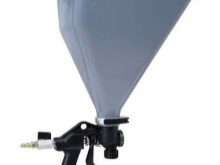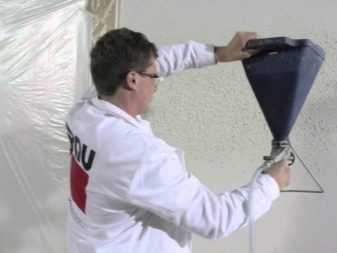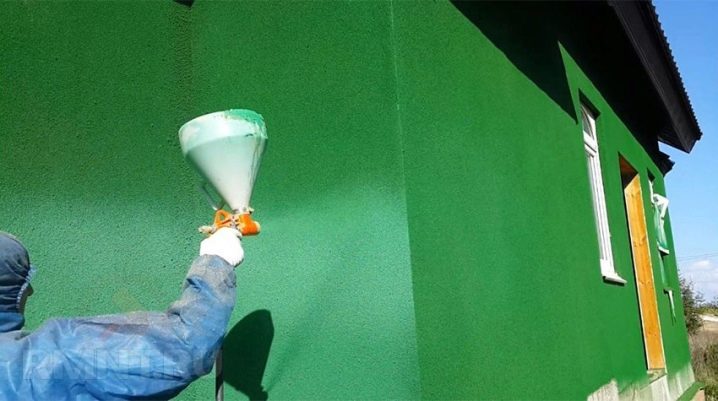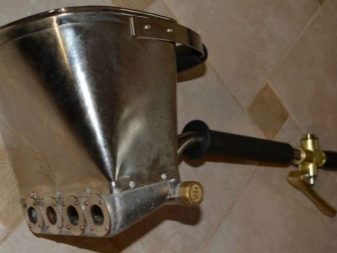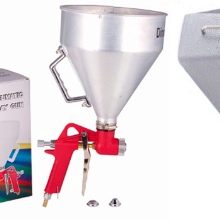Pistol Cartridge Gun: Application Features
Card pistol is a popular construction tool. It greatly facilitates the process of plastering surfaces and allows you to make high-quality repairs yourself.
Technical specifications
The card pistol is a semi-automatic device, consisting of the following elements:
- handle, equipped with a trigger, with which the device is turned on;
- a short barrel made of steel;
- the nozzle, complete with a set of nozzles with different diameter and shape of the outlet;
- funnel with a capacity of 3 to 5 liters,
- a housing equipped with a compressed air suction hose connected to the compressor;
- a compressor with a capacity of at least four atmospheres and a capacity of about 200 liters of air per minute;
- purge ramrod designed to eliminate blockage in the holes of the gun.
The principle of operation of the device consists in the following: high-pressure air flows into the gun nozzle, where the solution simultaneously flows from the tank. An air jet with a force blows the solution out of the apparatus and evenly distributes it over the surface.
For each composition is intended a certain type of nozzle.designed for a specific thickness of the solution and its granularity. From the consistency of the mixture depends on the angle of the socket on the diffuser nozzle. The thicker the solution, the larger the angle should be. For example, for work with a thick plaster composition, an indicator of at least 30 degrees should be chosen, and when working with liquid mixtures, an angle of 15-20 degrees will suffice.
The main differences between the cartouche pistol and the homemade hopper bucket are the lack of connection between the tank and the compressor and the angle of the solution supply. In the hopper, it depends on the angle at which the air jet is fed to the solution, and in the cartridge device it depends on the angle of the nozzle.
Features and benefits
The pneumogun is in high consumer demand, which due to the numerous advantages of the device:
- a large range of models allows you to work with any type of plaster, as well as use a gun for painting surfaces and forming a self-leveling floor;
- high density of the formed layer ensures the almost complete absence of pores and cavities, which significantly increases the strength and prolongs the service life of the coating;
- The high speed of work, reaching up to 60 m2 per hour, allows for plastering large areas in a short time;
- economical solution consumption;
- reasonable price (budget models cost no more than two thousand rubles);
- the possibility of forming a smooth and smooth coating without having the skills of finishing work.
Types of solutions
In the modern construction market, mixtures for a pistol pistol are presented in dry and ready-made forms. Dry formulations are in higher demand due to their low cost, ease of use and long shelf life.
Mortars are plaster or cement based and supplemented with a variety of additives that improve the viscosity and ductility of the material. Cement mixtures have high moisture-resistant properties and can be used to finish the facades of buildings, pools and bathrooms. Gypsum solutions are best used for plastering rooms with normal or low humidity. The advantages of gypsum are high elasticity and fine grain size of the mixture, good sliding and quick preparation of the solution.
The consistency of the mixture should be reminiscent of thick sour cream and freely "crawl" along the walls of the funnel. It is allowed to use marble or mica chips, which allows forming beautiful surfaces with an unusual structure. To create a textured surface with a further mechanical pattern application, it is better to use a more liquid composition. Cartridges can be refilled with any kind of solutions, including mixtures of glue and synthetic base.
Instructions for use
The first stage of work is the preparation of the surface for plastering, which consists in cleaning, dedusting and priming the working base.In the presence of large elevation differences, they should be eliminated by cutting off protruding elements with subsequent sealing of irregularities with the help of cement-sand mixture. Then you should install beacons that will serve as a guide for the thickness of the formed layer. Next, you need to start mixing the solution, during which you need to achieve its complete homogeneity, otherwise the surface may crack after drying. It is recommended to knead in small portions, strictly observing the proportions of the mixture and water. This is especially true for gypsum compounds that have a short “viability” and quickly set.
Compressor power should be set very carefully. With a weak head, the mixture will scatter in different directions and flow from the surface, and too much pressure will lead to pulling out the hose and stopping the work. It is recommended to keep the pneumogun at a distance of 35-40 cm from the wall. In the absence of experience using a pistol, you should choose a nozzle for a solution of medium thickness, and it is better to make the mixture a little more liquid than that used for manual plastering.Such an optimal ratio of the size of the nozzle and the thickness of the composition will help to acquire the necessary skills and quickly master the work with the gun.
The gun should be held at the waist level so that the jet of solution gets on the wall only at a right angle. You need to drive a gun in a straight line along the wall, and the next row overlap the previous one, moving in the opposite direction. Apply the solution should be in several layers, giving each of them time to dry.
The formation of a 2-centimeter layer at a time is unacceptable. The upper pre-finishing layer must be leveled with a rule, and after it is fully dried, it must be treated with a construction trowel. An exception may be a gypsum mortar, often performing the function of the starting and finishing layer at the same time. In this case, it is permissible to limit the application of a single layer of mortar up to 10 mm thick. Work should be carried out in compliance with individual protection measures, using gloves, goggles or a plastic shield.
Useful tips
During the work with the plaster gun it is necessary to control uniformity of the put layer.This will help prevent the appearance of cracks due to uneven drying of the composition. This is especially swinging cement mortars. When forming the centimeter layer, the average consumption of the mixture is 25 kg per one and a half square meters.
It is not recommended to fill up the funnel to the top. This will facilitate the work with the gun, allowing you to lift it to the desired height without much effort.
In order to avoid pneumatic impact and excessive firing of the mixture, press the trigger lever should be smooth and continuous throughout the entire cycle of application of the solution. When installing decorative plaster mixture is applied in several thin layers using the method of spraying.
Popular manufacturers
The most popular models, both among amateurs and professionals, are products of the Swiss brand. "Brigadier" worth 4200 rubles, equipped with a funnel made of aluminum, characterized by a long service life and high strength. Pistols are also popular. "Matrix"which can be purchased for two and a half thousand rubles. Company products also deserve attention. "Fubag", whose products are of high quality and low weight. The cost of such pistols is 3400 rubles.
Reviews
A card pistol is a popular finishing tool and has many positive reviews. Buyers note the ease of use of the device and high speed of work. They also pay attention to the possibility of self-repair without experience and certain skills. Of the minuses there is a large weight of some models, which, in combination with the filled capacity, creates some difficulties when applying the solution. Also, users say that it is necessary to use the entire prepared mixture at a time, which is necessary to avoid the composition hardening inside the device. Attention is drawn to the high cost of some models.
About plaster walls using a pistol pistol, see below.


